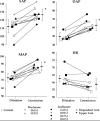Blood pressure response to thermoregulatory vasoconstriction during isoflurane and desflurane anesthesia
- PMID: 12859306
- PMCID: PMC1283105
- DOI: 10.1034/j.1399-6576.2003.00156.x
Blood pressure response to thermoregulatory vasoconstriction during isoflurane and desflurane anesthesia
Abstract
Background: Mild perioperative hypothermia produces morbid cardiac outcomes that may result from sympathetically induced hypertension. However, volatile anesthetics produce vasodilatation that may reduce the hemodynamic response to hypothermia. We tested the hypothesis that the volatile anesthetics isoflurane and desflurane blunt the normal cold-induced hypertensive response.
Methods: We analyzed prospective data from three analogous studies: 1) 10 volunteers given desflurane (2.6 volume percentage) maintained in left-lateral position; 2) nine volunteers without anesthesia or anesthetized with various doses of desflurane; and 3) eight volunteers given various concentrations of isoflurane. Mean skin temperature was reduced to 31 C, which decreased core body temperature and triggered thermoregulatory vasoconstriction. Mean arterial pressures were determined before and after hypothermia provoked intense thermoregulatory vasoconstriction.
Results: The hemodynamic responses to thermoregulatory vasoconstriction were similar without anesthesia and at all concentrations of desflurane and isoflurane. On average, mean arterial pressure increased 14 (SD = 5) mmHg with and without anesthesia.
Conclusion: We conclude that thermoregulatory vasoconstriction significantly increases arterial pressure with or without isoflurane or desflurane anesthesia.
Figures

Similar articles
-
Desflurane reduces the gain of thermoregulatory arteriovenous shunt vasoconstriction in humans.Anesthesiology. 1995 Dec;83(6):1212-9. doi: 10.1097/00000542-199512000-00012. Anesthesiology. 1995. PMID: 8533914
-
Desflurane slightly increases the sweating threshold but produces marked, nonlinear decreases in the vasoconstriction and shivering thresholds.Anesthesiology. 1995 Dec;83(6):1205-11. doi: 10.1097/00000542-199512000-00011. Anesthesiology. 1995. PMID: 8533913 Clinical Trial.
-
The threshold and gain of thermoregulatory vasoconstriction differs during anesthesia in the dependent and upper arms in the lateral position.Anesth Analg. 2002 Apr;94(4):1019-22, table of contents. doi: 10.1097/00000539-200204000-00046. Anesth Analg. 2002. PMID: 11916816
-
Cardiovascular responses to sevoflurane: a review.Anesth Analg. 1995 Dec;81(6 Suppl):S11-22. doi: 10.1097/00000539-199512001-00003. Anesth Analg. 1995. PMID: 7486143 Review.
-
Perioperative thermoregulation and heat balance.Ann N Y Acad Sci. 1997 Mar 15;813:757-77. doi: 10.1111/j.1749-6632.1997.tb51779.x. Ann N Y Acad Sci. 1997. PMID: 9100967 Review.
Cited by
-
Effect of active warming on perioperative cardiovascular outcomes: a systematic review and meta-analysis of randomized controlled trials.J Anesth. 2023 Aug;37(4):573-581. doi: 10.1007/s00540-023-03205-4. Epub 2023 Jun 8. J Anesth. 2023. PMID: 37291280 Free PMC article.
-
Effect of Prewarming on Perioperative Hypothermia in Patients Undergoing Loco-Regional or General Anesthesia: A Randomized Clinical Trial.Medicina (Kaunas). 2023 Nov 27;59(12):2082. doi: 10.3390/medicina59122082. Medicina (Kaunas). 2023. PMID: 38138185 Free PMC article. Clinical Trial.
-
What is the predictor of the intraoperative body temperature in abdominal surgery?J Anesth. 2019 Feb;33(1):67-73. doi: 10.1007/s00540-018-2585-6. Epub 2018 Nov 29. J Anesth. 2019. PMID: 30498930
-
Effect of season and diet on heart rate and blood pressure in female red deer (Cervus elaphus) anaesthetised with medetomidine-tiletamine-zolazepam.PLoS One. 2022 Jun 7;17(6):e0268811. doi: 10.1371/journal.pone.0268811. eCollection 2022. PLoS One. 2022. PMID: 35671269 Free PMC article.
-
Relation Between Temperature Extremes and Symptom Exacerbation in Patients With Hypertrophic Cardiomyopathy.Am J Cardiol. 2016 Mar 15;117(6):961-5. doi: 10.1016/j.amjcard.2015.12.046. Epub 2015 Dec 31. Am J Cardiol. 2016. PMID: 26810858 Free PMC article.
References
-
- Emmett JD. A review of heart rate and blood pressure responses in the cold in healthy subjects and coronary artery disease patients. J Cardiopulm Rehabil. 1995;15:19–24. - PubMed
-
- Juneau M, Johnstone M, Dempsey E, Waters DD. Exercise-induced myocardial ischemia in a cold environment. Effect of antianginal medications. Circulation. 1989;79:1015–1020. - PubMed
-
- Mangano DT. Perioperative cardiac morbidity. Anesthesiology. 1990;72:153–184. - PubMed
Publication types
MeSH terms
Substances
Grants and funding
LinkOut - more resources
Full Text Sources

